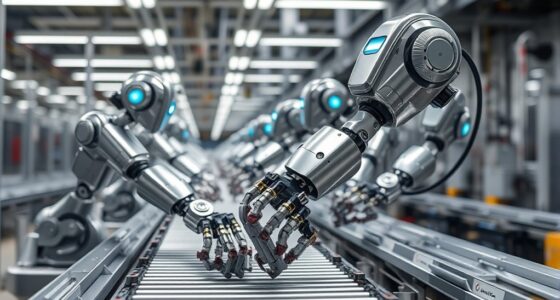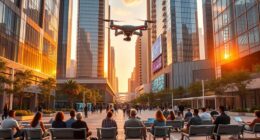Digital twins are reshaping your manufacturing workforce by enabling remote monitoring, real-time analysis, and smarter decision-making. As automation grows, you’ll need to develop skills in data analysis, visualization, and machine learning, shifting roles toward strategic and tech-driven tasks. This transformation encourages reskilling and creates new hybrid roles that blend blue- and white-collar skills. Staying ahead means understanding how digital twins drive operational efficiency and workforce adaptation—exploring this further reveals how your industry is evolving.
Key Takeaways
- Digital twins enable remote monitoring, reducing onsite workforce needs and promoting flexible, distributed manufacturing operations.
- The adoption of digital twins drives workforce reskilling, emphasizing data analysis, visualization, and machine learning skills.
- New roles may blend technical and strategic tasks, creating “sky-blue-collared” positions combining blue- and white-collar expertise.
- Digital twin technology fosters more agile decision-making, requiring workers to interpret complex virtual data for operational improvements.
- Investment in digital twins accelerates industry evolution, demanding ongoing workforce development to adapt to advanced manufacturing environments.

Digital twins are transforming manufacturing by creating virtual replicas of physical assets and processes, enabling you to simulate, analyze, and optimize operations in real time. This technology allows you to gain a detailed understanding of complex systems, helping you identify bottlenecks, test scenarios, and improve efficiency without disrupting actual production. As a result, your factory can operate more smoothly, saving costs and increasing output. Digital twins also support predictive maintenance, catching potential issues before they cause downtime, which keeps your operations running seamlessly.
The integration of digital twins profoundly impacts your workforce. Automation becomes more prevalent, prompting a need for reskilling workers to handle new roles focused on data analysis, visualization, and machine learning. You might find yourself learning to interpret digital twin data or manage automated systems, shifting from manual tasks to more strategic, tech-driven responsibilities. This change can lead to the creation of new “sky-blue-collared” roles that blend blue-collar expertise with white-collar skills, opening opportunities for workers willing to adapt and grow. Reskilling initiatives are crucial as organizations invest in workforce development to keep pace with technological advances. Additionally, data analysis skills are increasingly important as digital twins generate vast amounts of operational information, requiring workers to interpret and leverage this data effectively.
Remote monitoring enabled by digital twins also offers greater geographic flexibility. You can oversee factory operations from anywhere, reducing the need for on-site presence and improving your work-life balance. This flexibility means you’re less exposed to job hazards and can respond faster to operational issues, making your role more dynamic and less physically demanding. However, staying current with digital twin technology requires continuous upskilling, especially in analyzing and interpreting data to make informed decisions.
Remote monitoring with digital twins boosts flexibility, safety, and responsiveness while requiring ongoing data analysis skills.
As the market for digital twins expands rapidly—valued at over USD 17 billion in 2024 and projected to reach USD 110 billion by 2028—your industry is investing heavily in this technology. Major companies recognize the value of digital twins in enhancing operational efficiency, resilience, and innovation. They’re adopting decentralized and hyper-local manufacturing models, which improve responsiveness and productivity. This shift means you might work in more agile, responsive environments, where quick decision-making is essential.
Frequently Asked Questions
How Do Digital Twins Impact Employee Training Programs?
You see, digital twins revolutionize employee training by creating immersive, risk-free learning experiences. They let you practice complex tasks in virtual environments, reducing errors and boosting confidence. With real-time data and simulations, you can develop personalized learning paths that accelerate onboarding and bridge skill gaps. This technology also guarantees consistent knowledge transfer and enhances collaboration, ultimately making your training programs more effective, engaging, and aligned with operational needs.
What Skills Are Essential for Workers Operating Digital Twin Technologies?
Imagine stepping into a control room, where your hands manage sensors and analyze real-time data. You need strong data analysis skills to interpret insights, plus simulation modeling to predict outcomes. Your domain knowledge keeps operations smooth, while system integration guarantees seamless workflows. Managing IoT sensors, leveraging cloud tech, and safeguarding data with cybersecurity are essential. Critical thinking, communication, and adaptability help you troubleshoot issues and collaborate effectively in this high-tech environment.
How Do Digital Twins Influence Job Security in Manufacturing?
Your job security will likely evolve as digital twins become more prevalent. While some roles may change due to automation, you’ll find new opportunities in managing and analyzing digital twin data. Embracing ongoing learning and developing digital skills will help you stay valuable. Instead of replacing you, digital twins augment your capabilities, allowing you to focus on higher-value tasks. Adaptation and skill development are key to maintaining job security in this changing landscape.
Are Digital Twins Accessible for Small and Medium-Sized Enterprises?
You might wonder if digital twins are accessible for SMEs. Take Brew Masters, for example; they used cloud-based platforms and pre-built tools to create digital twins, improving supply chains and reducing costs. While challenges like data management and integration exist, leveraging cloud solutions and clear goals makes adoption feasible. With the right strategies, even small and medium-sized businesses can harness digital twins to optimize operations and stay competitive.
What Are the Potential Cybersecurity Risks Associated With Digital Twins?
You should be aware that digital twins can create new cybersecurity risks, like increasing attack points through connected sensors and cloud links. Hackers can manipulate data, gain unauthorized access, or control physical assets if security isn’t tight. Weak authentication and poor monitoring make you vulnerable to sabotage or theft. Plus, sensitive data exposed by digital twins could help attackers plan targeted strikes, risking your operations and critical infrastructure.
Conclusion
As you embrace digital twins, you’ll find they boost efficiency and reduce downtime—by up to 25%, according to recent studies. This technology transforms your manufacturing workforce, making operations smarter and more responsive. While some worry about job displacement, digital twins actually create new roles in data analysis and system management. By integrating this innovation, you’re not just keeping pace; you’re shaping a more agile, skilled, and future-ready workforce.









